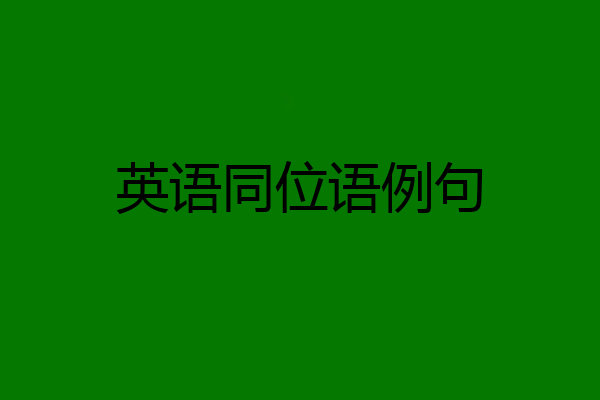
分享奇闻怪事
关于同位语从句的英语语法
1.同位语从句:whether
whether可以引导同位语从句,而定语从句不能用whether作为引导词。
He hasn’t made the decision whether he will go there.
他还没有做出决定是否去那里。
I have small doubt whether he is suitable for the job.
他是否适合这件工作我有点怀疑。
2.同位语从句:that
些名词的后面可以接that引导的同位语从句:
We came to the decision that we must act at once. 我们做出决定:我们必须立即行动。
He made a proposal that the meeting be postpone. 他提议会议延期。
There was little hope that he would survive. 他幸存的希望很小。
在非正式语体中that可以省略。
以下名词常用于以上句型:
advice, announcement, argument, belief, claim, conclusion, decision, evidence, explanation, fact, feeling, hope, idea, impression, information, knowledge, message, news, opinion, order, probability, promise, proposal, remark, reply, report, saying, statement, suggestion, thought, treat, warning, wish, word
3.同位语从句:what
what可以引导同位语从句,而定语从句不能用what作为引导词
I have no idea what he is doing now. 我不知道他现在在干什么。
4.同位语从句:how
how可以引导同位语从句,而定语从句不能用how作为引导词
It’s a question how he did it. 那是一个他如何做了此事的`问题。
5.同位语从句:who等
who, whom, which, when, where, why用来引导同位语从句
The question who should do the work requires consideration.
谁该干这项工作,这个问题需要考虑。
She raised the question where we could get the fund.
她提出这个问题:我们到哪儿去搞这笔资金。
6.同位语从句和定语从句的区别
1)同位语从句和先行词是同等的关系;而定语从句是用来修饰先行词,是从属的关系。
2)that在同位语从句中没有词义,不充当句子成分;而在定语从句中充当主语、宾语等句子成分。
3)whether, what, how可以用来引导同位语从句;而它们不能用来引导定语从句。


我许你一世安好
当两个指同一人或事物的句子成分放在同等位置时,若其中一个句子成分是用于说明或解释另一个句子成分的,那么用于起说明或解释作用的句子成分就叫做另一成分的同位语。(PS:句子中指代同一事物的两个词、片语或子句,称同位关系。一般跟在某些名词后面。后一成分通常叫做前一成分的同位语。)例句:Mr Wang, my child’s teacher, will be visiting us on Tuesday.王先生,我孩子的老师,星期二要来看我们。解释例句:Mr Wang 和 my child’s teacher 都是同一个人,也就是同一成分了,而 my child’s teacher 起到了解释说明Mr Wang是谁的作用,所以这个句子的同位语就是 my child’s teacher 再一例句:My sister, Helen Wilson, will travel with me.解释:句中My sister和Helen Wilson指的是同一个人,它们是同位成分,后一成分就叫做前一成分的同位语。

萱萱小宝
⒈由两个或两个以上同一层次的语言单位组成的结构,其中前项与后项所指相同,句法功能也相同,后项是前项的同位语。Mr. Smith,our new teacher,is very kind to us.我们的新老师史密斯先生对我们很好。our new teacher是主词Mr. Smith的同位语,指同一人。Yesterday I met Tom,a friend of my brother's.昨天我遇到了我弟弟的朋友汤姆。a friend of my brother's是受词Tom的同位语,指同一人。⒉如同位语与其同位成分关系紧密时不用逗点隔开;如同位语对其同位成分只作补充解释时可用逗点隔开。He himself told me that his brother John is a world-famous doctor.他本人对我讲,他的兄长约翰是一位世界闻名的医生。himself和John都是单一的字作同位语,与其同位成分之间不用逗点隔开。Yesterday I talked to my English teacher,Mr. James.昨天我与我的英语老师詹姆斯先生谈过了。同位语Mr. James补充解释my English teacher,同位语与其同位成分之间可用逗点隔开。⒊同位语除表示其同位成分的全部意义外,还可以表示部分意义。We Chinese people are brave and hardworking.我们中国人民是勤劳勇敢的。He is interested in sports,especially ball games.他喜欢运动,特别是球类运动。同位从句一般跟在某些名词如answer(答案),hope(希望),fact(事实),belief (信仰),news(消息),idea(主意;观念),promise(承诺),information(信息),conclusion(结论),order(命令), suggestion(建议),problem(问题),thought (想法)等后面。例如:He always works hard even if he knows the fact that he is not in good health. His failure was due to the fact that he had not practised for a long time. I had no idea that you were here. She told us her hope that she would become a pianist. He made a promise that he would never come late. 注意:that 既可引导同位语从句又可引导定语从句,其区别在于:同位语从句由连接词that引导,连接词that本身无意义,在同位语从句中不充当任何成分,不可省略,不可以用其他词替代;定语从句由关系代词that引导,关系代词that在从句中充当一定的成分,作宾语时可省略,由when,why,where引导的 同位语从句和定语从句的区别在于:同位语从句由连接副词只起连接作用,没有指代作用; 定语从句由关系副词引导,关系副词具有指代先行词的作用,常用一个介词加关系代词替换。例如:I will never forget the day when we first met. (定语从句,when关系副词) That is the special day (which/that) I will never forget. (定语从句,which/that为关系代词) This is the house where we lived fifteen years ago. (定语从句,where为关系副词) This is the house which we sold fifteen years ago. (定语从句,which为关系代词)